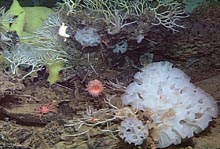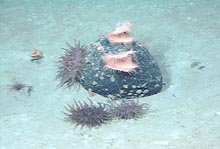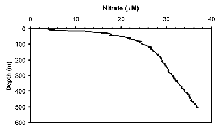
As vertical relief increases, animal life explodes. (Image courtesy Monterey Bay Aquarium Research Institute (MBARI) Click image for larger view.
Diversity of Animal Life on Seamounts
Edward W. Seidel
Associate Curator, Monterey Bay Aquarium
After observing deep-sea areas on and around seamounts for even a short time, one notices a stark pattern of where to find animals. Flat areas are a virtual desert with very little animal life, but as soon as there is some vertical relief, an oasis of animals explodes into view. Even something as small as a volleyball-sized rock is enough to become a haven for animal life.
This phenomena occurs for two basic reasons: Seamounts provide structure for animals to live on, and the structure creates oceanographic effects that promote the production of food. Many of these deep-sea animals, such as gorgonians, mushroom corals, and sponges, spend their entire lives permanently attached to rocks, and therefore depend on ocean currents to bring their food to them. A seamount, rising up out of the sea floor, has strong currents that frequently run over it, providing the animals living along its flanks with a constant supply of planktonic food.

Even small rocks become a haven for animal life. (Image courtesy MBARI) Click image for larger view.
These same currents also produce localized upwelling of water around the seamount. Nutrients like nitrates and phosphates, which are critical to the growth of phytoplankton, are lifted from the deep to the sunlit surface waters. These nutrients fuel an explosion of planktonic plant and animal growth, and attract larger animals such as whales, sharks, tunas, and seabirds to a veritable feast.
Seamounts are “hot spots” of biodiversity. Think of a seamount as an underwater island. Ocean currents carry larvae, like shipwrecked mariners, from various geographically distant areas. Seamounts provide a place for these lost larvae to settle and grow, so you find animals living side by side that normally are not found together.

This graph shows that nutrients increase in deeper waters. Currents around the seamount create upwellings that lift nutrients to the surface. (Image courtesy MBARI) Click image for larger view.
Davidson Seamount is geologically young but has remarkable biological communities, including large, dense patches of sponges and apparently extremely old coral forests, with individuals commonly reaching more than 3 m in height. Rare species, such as the black-footed albatross and the federally listed endangered sperm whales, have been sighted at the seamount. Two commercial fisheries currently operate in the waters above Davidson Seamount—drift gill netting for swordfish and sharks and trolling for albacore tuna. It is not known how or if these fisheries impact other species at the seamount. Its proximity to numerous fishing ports and the developing technologies in deep-water fishing make Davidson extremely vulnerable to increased fishing pressure.
Sign up for the Ocean Explorer E-mail Update List.















